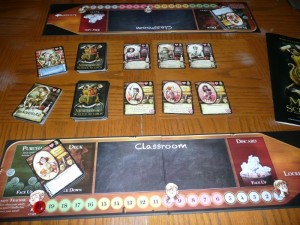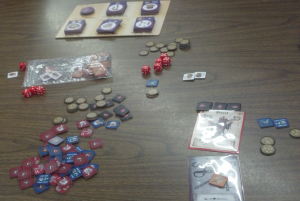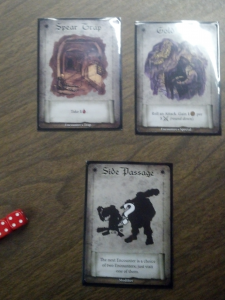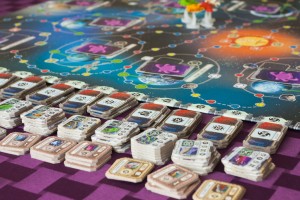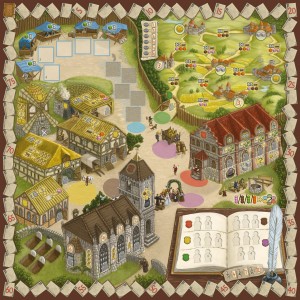 So the biggest problem with worker placement games is the huge front end of explaining how the game works. They can be a ton of fun, and they’re great for building tension as you try and figure out how you can manage to accomplish all of the things you need with limited resources. The newest Worker Placement game in my library is Village.
So the biggest problem with worker placement games is the huge front end of explaining how the game works. They can be a ton of fun, and they’re great for building tension as you try and figure out how you can manage to accomplish all of the things you need with limited resources. The newest Worker Placement game in my library is Village.
Now, one of the coolest things about this game is that people are going to die, and that’s not entirely a bad thing. In fact, when people die, they go to the village chronicle (the book in the lower right of the board) … well, as long as there is space. If there isn’t space they go to one of the unmarked graves in the lower left of the board. The game ends when the book is full, or all of the unmarked graves are. There are a lot of ways to get victory points, and if you have 3+ people in the chronicle you’ll get victory points. Depending on the number of players there are more or less spots, and there are limited spaces depending on your peoples’ jobs at the time of their demise. In a 4 player game 2 council members will be recorded, and 5 farmers. And it’s first come first serve, so sometimes you do want to die first.
However there’s more to this game than just dying. There are a mess of resource cubes. Each time you do something you earn one of them. And in general you can’t do a thing unless there are still cubes available for that are. So for instance, the council generally starts with 2 cubes. If they’re gone when your turn comes up you’re basically out of luck. Some tasks can be accomplished w/ the appropriate cubes but more often you’ll use time to get things done. Say you want to create a wagon so you can send one of your family off traveling to distant lands. It’ll take 2 time to for your dude to learn how to make a wagon and 2 more to actually make it. On a future turn it’ll only take 2 time to make a wagon… unless of course your dude dies in the meantime. Every 10 time, one of your dudes dies. And it has to be from your oldest generation. You start with four 1st generation people. The family action will get you three generation 2 people, then 3 and then 4.
There’s a market, which may well be the key to high scores, I haven’t yet seen anyone broach 60 points, though the board goes to 80. The game is a little long at 60-90 minutes, and probably will be longer the first few times you play, but it is quite fun once you get the hang of it, and trying to get your people killed off at just the right time can be kind of hilarious, as can be realizing you let one of your mans live too long. I’m certainly looking forwards to playing a game of this where everyone knows how to play.
